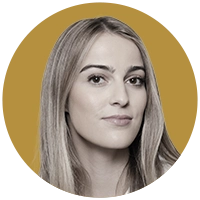Rothko Finds an Illuminating New Home at the City of Light
A sprawling retrospective at Paris showcases the late artist’s epochal output.

When one looks at a Rothko, color is often the first thing they notice. The man holding the brush above those great canvases, though, cared little for color. For him, it was all about light.
That is the stunning assertion of a new retrospective starring the Latvian-born American painter, Mark Rothko. The sprawling exhibit at the Fondation Louis Vuitton museum at Paris tracks his artistic arc into abstraction through an unprecedented assemblage of works from institutional and private collections at London, New York, San Francisco, and the District of Columbia.
Through April of 2024, 11 galleries will display some 115 works by Rothko. Born Marcus Rotkovitch in 1903, he emigrated with his family to America from what was then part of the Russian Empire at the age of ten. To tell his story was “the long-standing personal wish” of the president of the Fondation, Bernard Arnault. “He is still too poorly known and acknowledged in France and Europe,” Mr. Arnault writes in the forward to the exhibit’s catalog. “I therefore wanted the Fondation to redress this injustice.”
The journey begins with Rothko’s only self-portrait from 1936, greeting readers as they enter the exhibit. A set of black pupils punctuate his dark glasses, which conceal his gaze, giving the effect that he is possessed by some inner vision. Early on, that vision brought Rothko to relinquish the human form in favor of biomorphic elements, which spiraled into works of increasing abstraction.
“I belong to a generation that was preoccupied with the human figure, it did not meet my needs,” Rothko once asserted. “Whoever used it mutilated it.” Like the American artists Adolph Gottlieb and Barnett Newman, he searched for a universal language that could respond to the barbarism brought on by the turbulent international contexts of the 1940s. He obscured the subject, letting his brush meander across the painting without conscious control, vividly seen in his 1944 piece, “Slow Swirl at the Edge of the Sea.”
The influences of sundry strands of philosophy and mythology abound in these early works. A voracious student at Yale, Rothko drew from the likes of Nietzche, Aristotle, Kafka, and Tolstoy. His worn-down copies of their books are on display at the Fondation, as well as his records of 18th and 19th-century composers. “He took the colors from Matisse” — said his sister in the 2008 BBC film, “Rothko’s Rooms” — “and much of the emotional feeling from Mozart.”
Color soon replaced figure. Yet Rothko refused to be called a “colorist,” a title given to other mid-twentieth century artists who used hues to represent the subject of their paintings rather than depicting the subject itself. Rothko once asserted that “I’m not interested in color. It’s light I’m after.” Atop a coral background sits inky purple. Behind a tangerine rectangle emerges a dim blue. Yellow paint encounters a black border.
Lightness, for Rothko, does not translate to levity, as it tends to exist only adjacent to darker casts. “I would like to say to those who think of my works as serene,” said Rothko, according to a pane here outside a gallery of his works from the 1950s, “that I have imprisoned the most utter violence in every square inch of their surface.”
The “violence” that can be found in Rothko’s work intensified in the following decade. In a series of dark panels produced in 1964, “Blackforms,” chromatic harmony replaces chromatic explosion. The eyes must adjust to distinguish between blends of browns, purples, blacks, and grays. “If people want sacred experiences they will find them here,” Rothko said, according to a gallery panel. “If they want profane experiences they’ll find them here too.”
The exhibit’s final series, “Black and Gray,” abandons all color. Produced from his chapel-turned-art-studio in Houston during a period of worsening depression toward the end of Rothko’s life, these murals feature a black rectangle above a gray one, each varying only slightly in shade. Also displayed in this room are two large-scale sculptural figures by a Swiss artist, Alberto Giacometti, whose own near-monochromatic paintings inspired Rothko. Austerity and severity abound.

An exceptional arrival to the Fondation are the “Seagram Murals” from London’s Tate Gallery. These expansive paintings of black, white, and crimson vectors were commissioned in 1958 for the Four Seasons Restaurant in a new skyscraper, the Seagram Building, at New York City, but Rothko abandoned the contract. He did not want wealthy diners, it was said, treating the pieces like decorative objectives.
This symbiotic relationship between artist and viewer lends a profound emotional quality to Rothko’s elusive canvases. By gazing into the paint, viewers are, in a sense, looking at themselves. What they will find is a product of their own inclinations, or inhibitions. The viewer is thus a co-creator, who must risk “taking the journey,” as Rothko once said, or else “miss the essential experience.”

